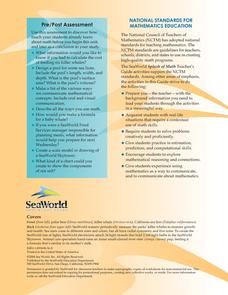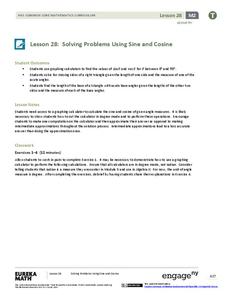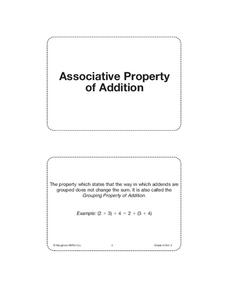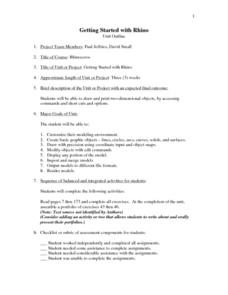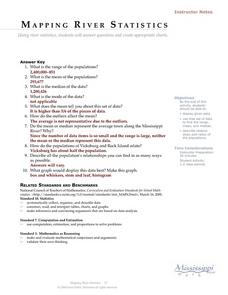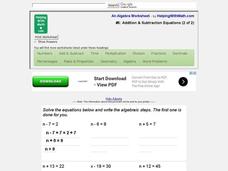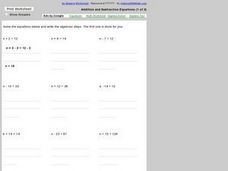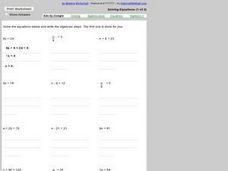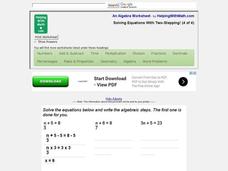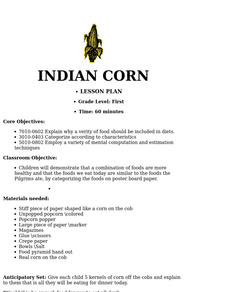Sea World
Splash of Math
How can kids use math to learn about marine life? Combine math skills with science lessons in a resource featuring activities about life in the sea. Kids graph and calculate data, solve complex word problems, measure geometric shapes,...
Arizona Department of Education
Area and Perimeter of Regular and Irregular Polygons
Extend young mathematicians' understanding of area with a geometry lesson on trapezoids. Building on their prior knowledge of rectangles and triangles, students learn how to calculate the area of trapezoids and other...
EngageNY
Solving Problems Using Sine and Cosine
Concepts are only valuable if they are applicable. An informative resource uses concepts developed in lessons 26 and 27 in a 36-part series. Scholars write equations and solve for missing side lengths for given right triangles....
Houghton Mifflin Harcourt
Unit 2 Math Vocabulary Cards (Grade 3)
A set of third grade math vocabulary cards include topics that range from addition properties to terms like estimate and fact family. Each sheet has two cards on it. The top half is the word printed in bold text,...
Inside Mathematics
Rugs
The class braids irrational numbers, Pythagoras, and perimeter together. The mini-assessment requires scholars to use irrational numbers and the Pythagorean Theorem to find perimeters of rugs. The rugs are rectangular, triangular,...
Curated OER
Rumors
Your young gossipers write an exponential function for the number of people who have heard a rumor after a number of days have passed. Learners then answer a series of questions, including whether or not the solutions are realistic by...
Curated OER
Getting Started With Rhino
Students draw and print two-dimensional objects, by accessing commands and short cuts and options. They customize their modeling environment, create basic graphic objects - lines, circles, arcs, curves, solids, and surfaces, and draw...
Curated OER
Scale Me Down
Students create scale drawings, and ultimately scale models, of real-world objects in this Math instructional activity about ratios, proportion, scaling factors, and cross products. The instructional activity includes ideas for...
Curated OER
Mapping River Statistics
Students research different statistics to do with the Mississippi River. They answer questions about finding data and collect it by conducting research. The research is used to construct a data table. Then students use the table to...
Curated OER
In the Bag!
Learners calculate how many quarters are in a $1,000 bag (after learning the dollar value of filled coin bags). They explain their problem-solving strategy using pictures, numbers, equations, and/or words.
Curated OER
Basketball Calculating Percentage
Seventh graders calculate percentages, convert fractions to decimals, and decimals to fractions using information from a basketball game.
Curated OER
Using Polya's 4 Steps to Problem Solving
Ninth graders solve problems using Polya's 4 steps to problem solving.
Helping with Math
#6: Addition and Subtraction Equations (2 of 2)
This printable contains 12 basic equations to be solved. The first one is worked out as an example, and the answers for all can be found by clicking on a "Show Answers" box found on the website. The publisher has identified this as...
Helping with Math
#5: Addition & Subtraction Equations (1 of 2)
Single-step addition or subtraction operations are applied in order to solve these 12 simple equations. An answer key is available, not so much for you, but perhaps to be used by learners as a self-correction tool. Note that the...
Helping with Math
#9: Solving Equations (1 of 2)
Twelve very simple equations are presented for learners to solve. What is the value of x? What is the value of n? Individuals apply operations to find the answers. You will find the final answers by clicking on the appropriate box at the...
Helping with Math
Solving Equations with Two-Stepping! (4 of 4)
Here are 12 two-step algebraic equations to be solved. The first problem is completed as an example to your class, but the remaining can be worked right on the page. An answer key is available by clicking on a small box at the top of the...
Helping with Math
Solving Equations with Two-Stepping! (2 of 4)
Multi-step problems are part of the progression when learning to solve equations. These 12 problems require only two steps to arrive at an answer. Either print the page out to assign as homework, or have learners write down the problems...
Helping with Math
#10: Solving Equations (2 of 2)
In this prealgebra activity, pupils perform addition, subtraction, multiplication, or division operations to solve for an unknown. There are 12 problems to be solved. Use this as a quiz to assess how well your class is grasping the skill...
Curated OER
Indian Corn
First graders demonstrate that eating combinations of food is very healthy. They discover that foods we eat today are similar to the foods the Pilgrims ate by categorizing the foods on poster board paper.
Curated OER
Home Sweet Home
Middle schoolers examine the change in the diversity of animals living in an area before and after development. In order to do this, students need to have access to an area near their school which is undeveloped. A good, "real life" lesson.
Curated OER
Subtraction Shopping
Students subtract two digit numbers. They check each other's answers for accuracy.
Curated OER
Hopper Hunt: IPM Decision-making in Alfalfa
Students describe migrations and life cycle pattersn of a key alfalfa pest, the Porato Leafhopper. They define the Economic Inquiry Level and Economic Threshold. Students evaluate data in relation to profit as it applies to IPM. They...
Curated OER
Ice Cream Lesson Plan for Kindergarten
Students explore how ice cream is made in a factory and at home. They help make ice cream in the classroom. They measure out the ingredients. Students share the ice cream when it is done.
Curated OER
Relating Division and Subtraction
Third graders relate the process of division to subtracting equal groups. Through guided practice and teacher demonstration, they complete division problems using a subtraction method. Students complete problems independently for...
